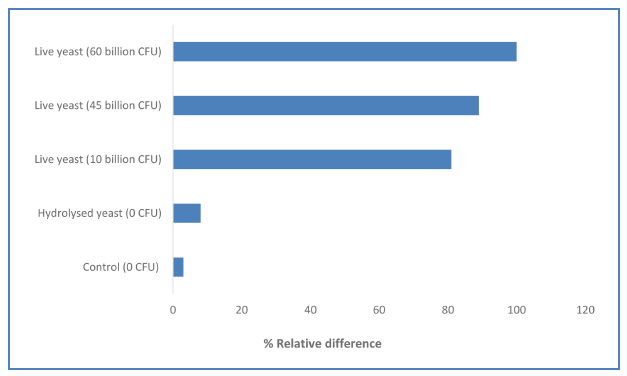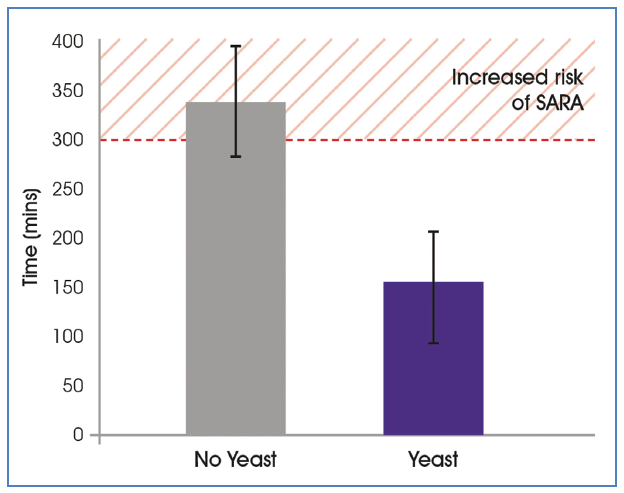The industrywide understanding of ruminant nutrition continues to progress with the advent of new insights into the rumen microbiome and subsequent improved feeding applications on-farm. Feed ingredients that work side by side with rumen microbes offer a best practice approach to optimising the rumen. Adding live yeast to livestock rations offers one such approach. This provides a unique mode of action among yeast products that may not only influence rumen microflora in a manner that supports a stable pH and improved fibre digestion, but is also the subject of increasing research as an antibiotic alternative in markets where consumer trends and legislation are influencing beef and dairy production.
Progression of yeast technology
Several different products are available in the yeast feed market, including yeast cell walls, hydrolysed yeast, yeast extracts and live yeast. However, live yeast is increasing in popularity as a feed additive in dairy, beef and swine markets to optimise rumen/gut function.
Live yeast products can be broadly split into two categories: Yeast predominantly selected for use in the baking and brewery industries is often referred to as first-generation yeast – it is also used in ruminant nutrition; and yeast specifically selected to work in the rumen, commonly referred to as second-generation yeast. These products have been selected based on advances in yeast technology, combined with nutritional expertise, to find strains that are ideally suited to performing in the rumen environment.
A unique mode of action
The key factor that differentiates live yeast from ‘dead’ yeast products, is the ability to ‘scavenge’ oxygen in the rumen (Newbold et al., 1996), as live yeast would preferentially use oxygen for metabolic processes.
Oxygen enters the rumen through ingestion and rumination, as well as diffusion from blood vessels in the rumen wall. However, anaerobic fibrolytic bacteria in the rumen are sensitive to oxygen. The removal of oxygen from the rumen results in an environment that is optimised for fibrolytic bacteria to proliferate, leading to improved fibre digestion and ultimately better animal performance.
The potential of live yeast to remove or scavenge for oxygen can be evaluated by measuring redox potential (Eh). The more negative the Eh the greater the potential to scavenge oxygen. During feed and water intake, the Eh is increased due to oxygen stress. Feeding live yeast maintains a lower redox potential even at times of feeding (Krizova et al., 2011).
Micro yeast and redox potential
Selecting a second-generation live yeast strain for use in animal nutrition, involves a series of screening tests, the first step being the selection of a small cell size, or ‘micro yeast’. Small yeast cells have a larger cell surface area allowing for a greater potential to scavenge oxygen. A smaller cell size also enables a higher colony forming unit (CFU) per gram to be delivered, giving live yeast the best possible chance of changing and optimising the rumen environment through the removal of oxygen.
These features, as well as other important characteristics that include survivability in the rumen and volatile fatty acid (VFA) production as a measure of fibre fermentation, are taken into consideration when selecting a second-generation live yeast strain that is best suited to improving rumen function and animal performance. Figure 1 shows the redox potential of live yeast strains versus a hydrolysed yeast product. The live yeast with the highest CFU count per gram had the greatest redox potential, demonstrating the relationship between cell size and the ability to scavenge oxygen.


Through feeding a live yeast such as Vistacell, which has a high CFU count and therefore increased capacity to scavenge oxygen, greater benefits can be seen in the rumen, including a higher rumen pH, increased VFA production, reduced lactic acid production and improved organic matter digestibility (Denoyers et al., 2009).
In dairy trials, Vistacell has shown performance benefits from improved fibre digestion in the region of 1,2kg of extra milk per day on average, with additional improvements in milk components (Ondarza et al., 2010). Depending on feed cost and milk price, this can give a return on investment of at least 6:1. Further trials with Vistacell at the recommended dose of 3g/h/d have shown improvements in both milk yield and feed efficiency.
Recent studies in beef cattle have also shown that diets supplemented with 1,5g/h/d of Vistacell had improved feed conversion ratios, better total tract digestibility, and better gain (feed efficiency and superior meat quality associated with the addition of Vistacell live yeast to the ration).
Putting rumen microbiology to work
The rumen of the cow contains up to 50 billion bacteria, as well as hundreds of thousands of protozoa and fungi, the make- up of which play a critical role in influencing not only fibre digestion, but also rumen function. Rumen pH fluctuates throughout the day, with levels falling around the time of feeding, driven by factors including increased lactate production and VFA accumulation (Dijkstra et al., 2012).
Cellulolytic bacteria are sensitive to a low pH (Newbold et al., 1996) and this poses a challenge to maintaining a stable rumen microbial population necessary for effective feed utilisation. Prolonged periods of low rumen pH are also associated with a negative impact on feed intake and can contribute to milk fat suppression (Dijkstra et al., 2012).
The first steps in understanding the interaction of yeast with rumen microbiology involved in vitro work, which helped to establish the oxygen scavenging and competitive exclusion modes of action of live yeast. In recent years, ruminant nutrition has taken a deeper look into microbiology. This advancement in science and methodologies is an exciting opportunity to better understand the mode of action and effect of live yeast in the rumen.
With the cost of sub-acute ruminal acidosis (SARA) being up to $1,12 (Enemark, 2008) per cow per day, the inclusion of live yeast in the ration has the potential of helping to mitigate the negative economic consequences of this form of rumen dysfunction and subsequent loss of production.
The addition of Vistacell live yeast to the ration has been shown to reduce the time the rumen spends below pH 5,6 by more than half (Figure 2), contributing to improved fibre digestion, increased microbial protein production and a reduced risk of SARA as a result of modifying the rumen microbiome (AlZahal et al., 2014).
Using a micro live yeast such as Vistacell with a high CFU count per gram and subsequent high oxygen scavenging potential, can potentially maximise the effect on the rumen. Optimising rumen conditions increases the stability of rumen pH, which allows for a more stable microbiota and improved fibre digestion. This leads to more consistent production in times of stress such as during the early lactation or receiving phase.
What next for live yeast?
Live yeast is a well-established probiotic ingredient that has traditionally been fed to improve performance. Live yeast can also assist in challenging conditions, such as when high starch diets are fed, or in times of stress, such as during the receiving phase or in heat stress situations. Live
yeast could also bring benefits in terms of immune modulation and pathogen binding (Posodas et al., 2017). This may have particular relevance in markets where there is a drive to reduce the use of antibiotics in beef and dairy production.
In conclusion
The profile of the rumen microbiome is a critical factor in terms of how effectively feed is utilised and will have a notable impact on profitability. Adding live yeast to the ration can help to create a rumen environment that enables optimal fibre digestion, as well as supporting effective rumen function through a unique mode of action that combines oxygen scavenging with probiotic effects.
It is this ability to favourably modify the rumen environment that is driving increased research into live yeast as a means of supporting rumen function.
References available on request. For more information, send an email to dean@avipharm.co.za, michael@avipharm.co.za or emea@abvista.com or visit the website at www.abvista.com.